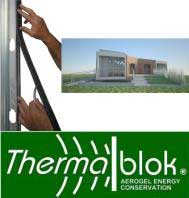Jul 2 2009
Living green is a matter of striking the right balance between innovation and environmental stewardship. With that in mind, Tampa-based Thermablok(R) donated 2,000 linear feet of its revolutionary aerogel insulation material to California architecture and design students participating in the 2009 "Solar Decathlon." The Solar Decathlon is a prestigious international competition sponsored by the U.S. Department of Energy that challenges 20 college and university teams to design, build, and operate the most aesthetic, energy-efficient model home possible.
 (L) Just 1/4-inch thick strip of Thermablok on each stud increased the R-value by more than 40-percent; (R) Rendering of the SCU/CCA 2009 Solar Decathlon house
(L) Just 1/4-inch thick strip of Thermablok on each stud increased the R-value by more than 40-percent; (R) Rendering of the SCU/CCA 2009 Solar Decathlon house
When students from the California College of the Arts (CCA) and the Santa Clara University, California began preparing for the competition, they approached Thermablok(R) President and founder Lahnie Johnson for information regarding energy-conserving Thermablok aerogel insulation. Thermablok's aerogel nano-technology, developed in conjunction with NASA, is the highest insulating material known to exist.
It is estimated that 40-percent of our energy is used controlling the temperature in buildings alone. Most of this energy escapes from the building primarily through the conventionally insulated walls and windows in a process termed thermal bridging (an ever greater problem when popular foam is used in a wall.)
Taking the newly discovered aerogel insulation technology, Thermablok(R) developed a highly efficient product that may soon become a standard in the building industry. Tests by the U.S. Department of Energy's Oak Ridge Laboratory and J.M. Laboratory indicate that adding just one, 1/4-inch x 1 1/2-inch (6.25 mm x 38 mm) strip of Thermablok to each stud before hanging drywall breaks the conductive "thermal bridging" path, and can increase the overall wall R-factor by more than 40-percent.
Thermablok is virtually weightless, 100-percent recyclable, hydrophobic (will not combine with water) and consists of more than 95-percent air, making it easy and inexpensive to ship, store and install. It is Class "A" fire rated with Cradle to Cradle Silver certified and will not age.
Team California is out to prove that artistic design and engineering can work together to create an awesome living space with their REFRACT house, an innovative solar design that they say will offer real green technology solutions like Thermablok and other renewable energy sources, as well as opportunities to use energy more efficiently.
Utilizing their craft and artisanal skills, and taking into account California's fabulous climate, the students (all undergraduates) are designing and building the 800-square foot home that "is completely powered by solar energy which doesn't compromise the planet, lifestyle, comfort, or aesthetics," said Kadee Mardula, a participating Santa Clara University student.
With energy needs dictating the future of housing design and development, most people welcome innovative sustainability ideas. Situated in the San Francisco and Silicon Valley region, a hub of environmental consciousness, Team California is uniquely qualified to take green living to a new level. Their motto: "Green living isn't a compromise. It's the new standard."
Students are scored in 10 categories: architecture, engineering, market viability, communications, comfort, appliances, hot water, lighting, energy balance, and transportation. Each house must produce enough electricity and hot water to perform all the functions of a home and also to power an electric car. The competition focuses on cutting edge energy efficiency and renewable energy innovation while providing a unique green jobs training opportunity for each of the students
Construction is taking place on the Santa Clara University campus. Once built, they will disassemble the house, truck it across the country to Washington DC, and reassemble it on the National Mall to be open for judging and public viewing October 8-18.
Started in 2002, the Solar Decathlon is a biannual event. Santa Clara University's involvement in the 2007 competition drew third place honors from the judges even though it was the smallest university involved in the competition, beating out top competitors including Massachusetts Institute of Technology (MIT) as well as two-time winner the University of Colorado at Boulder. SCU earned top marks for its advanced engineering.
Thermablok and its parent company, Acoustiblok, Inc., an international acoustical research company, are proud to sponsor environmentally important projects in the worldwide community such as the Solar Decathlon. NASA has been developing aerogel insulation technology for several years, using it on the space shuttle, in space suits, and for other advanced insulation requirements including the latest and future Mars missions. With the potential to revolutionize energy conservation; as recently reported on the Science Channel's Ecopolis program, Thermablok aerogel will be the breakthrough in building energy-conserving buildings.